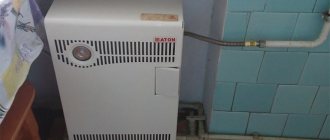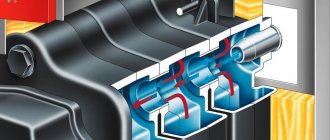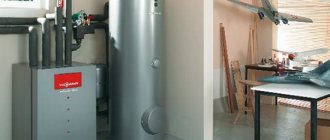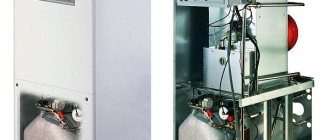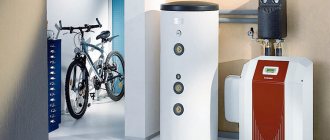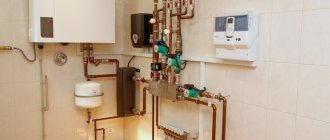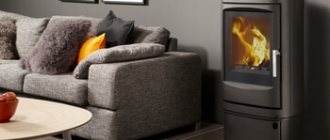Gas boilers are considered the most convenient and efficient sources of thermal energy.
Several design options have been developed that have remained virtually unchanged for many years.
Manufacturers create only certain variants of basic circuits based on the initially developed design.
All functions of the units are additions to the main type of gas boiler - a single-circuit floor-standing model designed to perform the main task.
Let's take a closer look at them.
Floor-standing single-circuit gas boilers and their features
The design of floor-standing single-circuit gas boilers is economical and simple.
They are capable of performing a single basic function - heating the coolant for the heating system . These units do not perform any additional tasks, therefore the set of units and parts of the unit is limited - only the most necessary elements are involved in the work.
In addition, the floor mounting method allows the use of durable and powerful units with increased weight and capabilities.
This makes the design more powerful and capable of high performance.
Most models are equipped with massive heat exchangers that have a high heat transfer capacity and can accommodate an increased volume of liquid. There are no restrictions on weight or dimensions for floor-standing boilers, so the power can be 100 kW or more.
Many units can be connected in a cascade (usually up to 4 units), creating a high-power thermal station.
Another feature of single-circuit floor-standing boilers is the ability to connect an external storage boiler.
This combination allows you to get not only heating of the house, but also a stable supply of hot water.
Most experts consider this option more preferable than using a double-circuit boiler, since the mode of supply of hot water from the boiler is smooth, without temperature jumps or pauses.
Rating of gas boilers
So, let's move on to the rating of the best gas boilers for heating a private home. Let's start with the wall ones.
Wall mounted
Which is the best wall-mounted double-circuit gas boiler is a difficult question, because there are a huge number of manufacturers working in this area who have long proven themselves on the positive side. And yet we will try.
See also: Catalog of companies that specialize in autonomous gasification
Bosch Gaz 7000 W MFA
The German manufacturer offers a unique unit that can operate on both natural and liquefied gas. The line also includes single-circuit models. Boiler power is from 24 to 33 kW.
Design features:
- ceramic monothermal heat exchanger;
- stainless steel burner;
- electronic ignition;
- two water heating modes: “eco” – when water is needed as needed, “comfort” – maximum heating;
- you can connect the boiler through a three-way valve;
- automatic system, with which you don’t have to worry about thermal inertia;
- Efficiency – 91%.
Gas boilers from BOSCH Source stroy-podskazka.ru
Baxi Eco Four
This is a representative of Italian production. It can also run on both liquefied and natural gas. The manufacturer produces two power models: 14 and 24 kW.
Design features:
- copper heat exchanger;
- heat exchanger for domestic hot water made of stainless steel;
- The burner is made of the same material;
- there is an automatic system that protects the boiler from freezing and blocking;
- sensor responsible for water movement;
- automatic bypass;
- weather-compensated automation;
- electronic self-diagnosis;
- flame modulation – electronic.
Gas boiler Baxi Source krayinatepla.com
Vaillant turboTEC plus VU INT
This is another German whose power varies in the range of 12-36 kW. These are single-circuit models with a closed fuel combustion chamber.
Design differences:
- copper heat exchanger;
- chromium-nickel steel burner;
- step circulation pump;
- automatic air vent;
- equipment freeze protection system;
- electronic ignition;
- Efficiency is above 91%.
Boiler from the Vaillant company Source kak.znate.ru
Advantages and disadvantages
The advantages of floor-standing single-circuit boilers include::
- simplicity, absence of unnecessary components and parts;
- reliability, stability;
- high power, ability to heat large areas;
- the presence of powerful and efficient heat exchangers with a high heat transfer coefficient;
- the floor mounting method simplifies the installation and connection of the unit;
- management of single-circuit models is simple and accessible to all users;
- There is a large selection of designs that allow you to obtain the most suitable type of boiler for the given conditions.
The disadvantages of floor-standing single-circuit boilers are:
- lack of independent ability to supply hot water;
- the specifics of the work require the allocation of a special room - a boiler room, equipped with window and door openings;
- atmospheric or non-volatile models are connected to the central common house chimney, which determines the location of their installation;
- increased power automatically means increased fuel consumption.
NOTE!
Most floor-standing single-circuit boilers are used in private homes or public spaces, where it is possible to provide all the conditions for the normal operation of the unit. The use of these models in apartments is impractical, since the dimensions and specific features of floor-standing boilers are excessive in such conditions.
Low power application
Heating equipment with reduced performance, running on natural or liquefied gas, is designed to maintain comfortable air temperature in apartments up to 100 m². Due to possible heat losses (for example, through the walls of a house or window openings), it is recommended to take into account a correction factor that reduces the size of the serviced room by 15-20%. Since the design does not include electronics, the heaters can be used in buildings not connected to AC power.
When using a 5 kW gas boiler, the following conditions must be met:
- high-quality insulation of walls, flooring and ceilings;
- no gaps between window frames, door frames and load-bearing surfaces;
- the height of the premises should not exceed 2.7 m;
- the house should not be located in a climate zone with prolonged frosts below -15°C.
Small-sized gas-type heating systems are easy to operate and configure.
The small size of the heat exchanger has a positive effect on fuel consumption and efficiency. Disadvantages of the equipment include a limited selection of models and the lack of additional functions. Boilers produced by small Chinese companies are equipped with original design elements, which makes repairing the equipment difficult.
Operating principle
The operation of a single-circuit floor-standing gas boiler consists of flow-through heating of the coolant using thermal energy obtained from fuel combustion.
The liquid enters the heat exchanger, receives the maximum possible heating for a given operating mode and enters a three-way valve . This is a unit where the hot coolant is mixed in a given proportion with the colder return flow.
The more return is added, the lower the temperature of the liquid entering the heating circuit. This is how the room heating mode is adjusted. The coolant moves under the action of a circulation pump, and the air supply and smoke removal are controlled by a turbofan.
The operation of all components is under continuous monitoring of a self-diagnosis system - a network of sensors installed on important components and parts of the boiler.
If abnormal situations occur or any elements fail, the sensors signal to the electronic control board, which immediately generates an error signal.
Some types of malfunctions cause immediate shutdown and blocking of the boiler for safety purposes; the control unit simply notifies the user about minor malfunctions.
IMPORTANT!
All problems that arise must be resolved only by qualified specialists with appropriate clearance. Unauthorized interference with the boiler design is an administrative offense.
What are its advantages of energy-dependent species
Non-volatile installations operate only on a mechanical principle, without needing to be connected to the power supply system.
This makes them indispensable in remote villages, in areas with dilapidated or overloaded electrical networks . Frequent shutdowns cause the heating to stop working, which is unacceptable in the Russian winter.
Non-volatile models ensure continuous heating of the house regardless of external conditions. However, such possibilities limit the capabilities of non-volatile boilers. They work only on natural physical processes - circulation of the coolant requires installation of the heating circuit at a slight angle and is based on the rise of warm layers of liquid upward.
Smoke removal occurs under the influence of normal draft in the chimney. It must be taken into account that natural processes occur with minimal intensity and are unstable, so external additional devices are usually installed - a turbo nozzle and a circulation pump.
They make the unit more productive, and operation in non-volatile mode occurs only during a power outage.
If there is no power supply to the house at all, only the basic capabilities of the unit are used.
Choosing a gas heating boiler
Let's start with the fact that on the modern market there is a huge variety of heating boilers that run on natural gas. They differ from each other not only in technical and operational characteristics, but also in purely design features. Therefore, we will compare boilers according to different positions, and then provide a rating of gas boilers.
Floor or wall mounted boiler
From the names of the two gas units it is clear that one is installed on the floor, the second is hung on the wall. But this is not the only difference between them.
Firstly, wall-mounted models are low-power compared to floor-mounted ones. Therefore, they are installed in small private houses. Although there is an option when one floor-standing unit is replaced with two or three wall-mounted units, connecting them to different heating circuits. This type of heating system is often used in large houses with several floors. That is, the owner has the opportunity to weakly heat that part of the house where people are rarely present, which leads to significant savings in gas fees.
Gas boiler: floor or wall mounted Source gazblog.ru
Wall-mounted boilers have a small weight - no more than 80 kg. The reason is because they are wall mounted. As for power, it does not exceed 35 kW, and the tank capacity does not exceed 40 liters. That is, this is an excellent option for a house with a total heated area of 100-120 m². But wall-mounted models have two more significant advantages:
- There is no need to organize a separate boiler room for it. Any utility room will do.
- In this case, all wall-mounted units are equipped with a closed combustion chamber. That is, their design includes a coaxial chimney, which is built into the wall where the boiler itself is located. The chimney simply sticks out on the street from the wall of the house in a horizontal position.
In this regard, floor-standing appliances are heavier. Their minimum weight is 100 kg. They are more powerful in terms of generating thermal energy and are larger in size. Therefore, they can only be installed in premises that meet the requirements of specialized SNiP. That is, such premises must comply with standard dimensions: ceiling height, height of the foundation on which the boiler is installed. A very important parameter is the air exchange rate. That is, there are a lot of problems with the floor-standing unit.
Wall-mounted models powered by gas Source demo.landistore.com
Plus, these models are mainly equipped with open-type combustion chambers. Therefore, it is necessary to install a properly designed chimney for them. And the air flow must be appropriate.
But it should be noted that wall-mounted gas boilers have a thin spot - this is the heat exchanger. It is made of either steel or copper. The second option is expensive, but it will last two or three times longer than steel. Why - because condensation will constantly form on the steel heat exchanger, which leads to corrosion processes. And this is a serious minus.
As for floor-type heat exchangers, they are made of cast iron. After all, the weight of the unit as such does not matter here. There is no need to broadcast it on the wall. And cast iron will serve faithfully for decades. So in this regard, floor-standing models are better.
It is clear that in terms of price, wall-mounted ones are preferable. In addition, it should be added that they are equipped with both a circulation pump and an expansion tank. That is, all this is already included in the cost of heating equipment. For floor-mounted ones, both elements will have to be purchased separately. And this is another additional expense item.
Copper heat exchanger for gas boiler Source static.wixstatic.com
Connecting a gas boiler, both floor-mounted and wall-mounted, is not the easiest process. In this regard they are equal. The main thing is no amateur performance. This should be done by professionals.
Single or double circuit boiler
What is the difference between a double-circuit gas boiler for heating a private house and a single-circuit one? Let's start with the last one. This is a classic heating option. It contains one heat exchanger, which heats the water circulating through the heating system.
Double-circuit gas boilers are designed for heating and hot water supply. They have two circuits, two heat exchangers, hence the name. But it should be noted that heating water for a hot water supply system can be done differently in different models. Manufacturers of gas boilers use three options:
- A flow-through heating element is used.
- A separate heating tank is installed in the boiler body.
- A boiler is installed next to the boiler.
Now about the choice. It would seem that the optimal solution is to choose a double-circuit gas boiler for heating for a large house, and a single-circuit gas boiler for a small house. But it's not that simple.
Double-circuit gas boiler with two heat exchangers Source koffkindom.ru
The operating principle of a double-circuit gas boiler is as follows: two circuits cannot operate simultaneously. That is, when the hot water supply system is turned on for consumption, the circuit to the heating system is turned off. This is done in order to increase the efficiency of water heating in the DHW system. It turns out that while you are bathing in the bath or taking a shower, the heating radiators in your house are gradually cooling down.
Another situation often happens. You are taking a shower, and your wife decided to wash the dishes. The result is that you get a contrast shower, when either hot or cold water flows from the watering can. It may not be possible to solve the problem by purchasing a more powerful double-circuit gas boiler. An accurate calculation of both the heating system and hot water supply will be required regarding hot water consumption.
There is a way out - install one or more single-circuit gas boilers for heating, and use a boiler for the hot water system. The latter is selected by volume. For example, if this parameter is 200 liters, then it is enough for a family of 5-6 people. The boiler itself is a heat-insulated steel container in which a coil is installed that acts as a heat exchanger. It is connected to the heating system, so there will always be hot water in the house.
Single-circuit wall-mounted gas boiler with boiler Source oteple.com
But compared to double-circuit gas boilers for heating and hot water, this combination will be more expensive. In addition, you will have to organize a separate room for it.
And one more drawback. The practice of operating double-circuit boilers shows that often, due to increased water hardness, the DHW heat exchanger quickly fails. And its repair is almost 50% of the cost of the entire boiler.
If we think sensibly, then the optimal solution for installing double-circuit floor and wall-mounted gas boilers for heating and hot water would be a small private house.
See also: Catalog of popular house designs for year-round use
Convection or condensation boiler
Scientific and technological progress has recently presented a large number of technologies and materials. He did not bypass heating units either. Therefore, today there are two types of gas boilers on the market, which are based on different heating methods. This is the traditional option, also known as convection and condensation.
How does a regular gas boiler work? Natural gas burns in the firebox, which heats the heat exchanger, inside which water moves. In this case, the burned fuel releases a certain amount of thermal energy, which is not completely used by the boiler. She simply flies out into the street through the chimney. Hence the efficiency of such devices is no higher than 90%.
Gas condensing boiler Source www.vaillant.info
Condensation models differ in design in that they have two chambers. In one, fuel burns, in the other, carbon monoxide and excess heat condense on the surface of the heat exchanger. The condensation process is accompanied by the release of thermal energy, which increases the heating temperature of the heating water.
It should be noted that condensing units are economical. And it would seem that replacing convection heating devices with condensing ones will lead to significant savings in natural gas. But here, too, not everything is so simple.
Condensate from burnt gas is a chemically active liquid. Not any material can withstand it. This means that both the heat exchanger and the chimney must be made of appropriate materials. And this leads to higher prices for heating equipment. In addition, the condensate will need to be drained somewhere. Problems can arise here too.
For example, active liquid cannot be drained into a septic tank or sewer. This means that additional equipment will be needed to neutralize the condensate. Plus, you can’t do without consumables here either.
Operating principle of a condensing boiler Source teploknam.ru
There is one more nuance that will have to be taken into account when purchasing a condensing gas boiler. It does not work well in high temperature heating systems. Usually this is a radiator option. The thing is that the outlet water temperature is +50C. In contact with the heat exchanger, where the water is not lower than the indicated value, condensation occurs weakly. This means that thermal energy will be released weakly. That is, the efficiency of the unit will decrease. It will be good, but not maximum.
But if the system has a heated floor, then condensation models here will show themselves in the best possible way. Because this type of heating requires water with a temperature of no more than 30-35C. Therefore, the condensation process on the heat exchanger will occur more efficiently.
That is why manufacturers of condensing boilers indicate two efficiencies in their data sheets: for a system with a temperature of 30-50C and for a system with a temperature of 30-50C and for 50-80C. That is, it turns out that if the question is which type to choose from the two indicated above, then everything will depend on what type of heating is installed or planned to be installed in the house.
Kinds
There are several design options for floor-standing single-circuit boilers. They differ from each other in various ways.
By type of combustion chamber:
- atmospheric (open) . The air directly surrounding the boiler is used, and the smoke is removed under the influence of natural draft. Such models are connected only to the central vertical chimney;
- turbocharged (closed) . To supply air and remove smoke, a coaxial type chimney is used (pipe in pipe), or two separate pipelines that perform the functions of intake and supply of air to the boiler and exhaust of flue gases.
According to heat exchanger material:
- steel. The most common option used on inexpensive models.
- copper. The coil-shaped design increases the path of liquid passing through the heating zone. Such units are installed in expensive models from top manufacturers;
- cast iron. Installed on powerful and massive units. Cast iron heat exchangers demonstrate high performance, efficiency, and are capable of developing large units of power. Used for units from 40 kW and above.
By heat transfer method:
- convection Conventional heating of the coolant in the flame of a gas burner;
- parapet. They are able to do without a heating circuit, being a kind of analogue of a conventional stove;
- condensation The coolant is heated in two stages - first in the condensation chamber, from the heat from the condensing flue gases, and then in the usual way.
NOTE!
Condensing boilers are able to fully operate only with low-temperature systems (warm floors), or when the difference in temperature outside and indoors is no more than 20°. These conditions are not suitable for Russia.
Floor models
The Premium 7.5 unit, developed by Lemax, belongs to the category of single-circuit non-volatile equipment. The boiler is connected to centralized gas supply lines, and the possibility of using liquefied fuel is provided. The design includes brackets for installing an indirect boiler that supplies heated water to the mixers. The standard heat exchanger is made of steel sheet 2 mm thick, connected by resistance welding. The surface is covered with heat-resistant enamel, which prevents corrosion of elements.
The gas is atomized by a small-sized burner from the Italian manufacturer Polidoro; the line is equipped with a SIT safety valve, which allows pressure drops in the pipeline. The design does not contain electrically controlled elements; the boiler can be used in places with unstable power supply.
To ignite the fuel, a piezoelectric element is used, which is activated when the button is pressed. At the bottom of the housing there are ventilation windows that supply heated air into the room.
The Lemax plant offers a 6-kilowatt AOGV unit of the Gazovik series, used for organizing heating in residential buildings. Under the heat exchanger there is an open combustion chamber, air is supplied from the room. Hot gases pass through the radiator and are then released into the atmosphere through a channel with a diameter of 112 mm. The temperature of the combustion products does not fall below 110°C, the manufacturer claims an efficiency of 87%. The installation has a height of 680 mm, weight is 35 kg, the design does not provide for connecting an additional boiler.
Another representative is the Russian-made 8 kW floor-standing gas boiler HotSpot ECO KSts-G-8S. To heat the coolant, a steel heat exchanger is used, equipped with protection against temperature rise. The manufacturer claims an efficiency of 92% and a service life without major repairs. The cylindrical radiator has increased strength; the heater can be used in a closed heating system with forced circulation (the pump must be purchased separately).
Do you need a boiler?
The need to connect a boiler is dictated by the needs of the room and users
If the unit operates in a private house, then installing a boiler will allow you to organize the supply of hot water in sufficiently large volumes.
However, if there is a connection to a centralized water supply, purchasing an external boiler seems impractical.
How to calculate the optimal value of the thermal power of a gas boiler?
Why buy a boiler more powerful than required if this will certainly lead to unnecessary costs not only at the time of purchase, but also during operation. On the other hand, giving away a lot of money and freezing in the winter, washing your face with cold or lukewarm water is, to put it in TV serial language, a loss of losses!
The simplest method for selecting the golden mean: 1 kW per 10 m² of serviced area. However, this is very approximate and some important parameters are not taken into account. For example, such as: the climatic coefficient of a particular region, the degree of thermal insulation of the walls, the level of probable heat loss, the volume (and not just the area) of the room, etc.
This means that a more accurate calculation is needed. There are two ways: use publicly available formulas that take into account the above criteria (you have the opportunity to remember your school years) or act more rationally and use a special calculator, which are a dime a dozen on the Internet.
The most popular manufacturers and their brief descriptions
The leading manufacturers of floor-standing single-circuit boilers are European companies, although domestic designs are optimal for Russian conditions.
The most famous companies are:
- Viessmann. A German company, one of the most famous and reliable companies producing thermal products;
- Protherm. A company from Slovakia that produces a wide range of heating boilers. ALL series are named after animals of different species;
- Buderus . “Daughter” of the world-famous concern Bosh, which fully characterizes the quality and reliability of the products;
- Vaillant. Another German company whose boilers are considered the highest quality and most reliable;
- Lemax. Russian manufacturer of energy-independent floor-standing gas boilers. When developing the project, all the features of working in difficult conditions were taken into account;
- Navien. Korean boilers that successfully combine high quality and affordable prices.
The list of manufacturers can be continued for a very long time. All currently operating companies care about the quality and reliability of their products, trying to surpass competitors and reach the maximum number of users.
Rating of TOP 10 best models
| Place | Name | Price |
| TOP 5 best Russian floor-standing single-circuit boilers | ||
| 1 | Lemax Premium-20 | 25 000 ₽ |
| 2 | Lemax Premium-12.5 | 21 000 ₽ |
| 3 | Lemax Leader-35 | 53 000 ₽ |
| 4 | ZhMZ AOGV-17.4-3 Comfort N | 21 000 ₽ |
| 5 | Rostovgazoapparat AOGV | 20 000 ₽ |
| TOP 5 best foreign floor-standing single-circuit boilers | ||
| 1 | Protherm Wolf 16 KSO | 19 000 ₽ |
| 2 | BAXI SLIM 1.230 iN | 55 000 ₽ |
| 3 | MORA-TOP SA 20 G | 30 000 ₽ |
| 4 | MORA-TOP SA 60 | 25 000 ₽ |
| 5 | Protherm Bear 40 KLOM | 57 000 ₽ |
The best Russian floor-standing single-circuit boilers
Let's look at the most popular models of Russian floor-standing gas boilers:
Lemax Premium-20
Products of the plant of the same name from Taganrog. A non-volatile floor-standing boiler with a power of 20 kW is capable of heating a house of 200 square meters. m.
Its main characteristics:
- Efficiency - 90%;
- coolant temperature (max) - 90°;
- heating system pressure (max) - 3 Bar;
- fuel consumption - 2.4 m3/hour;
- dimensions - 556x961x470 mm;
- weight - 78 kg.
The high demand for Lemax boilers indicates the demand and positive attitude of users towards domestic heating units.
Lemax Premium-12.5
Another representative of the Taganrog plant, designed for work in relatively small spaces. With a power of 12.5 kW, this boiler can heat an area of 125 square meters. m., which is suitable for country houses or country houses.
Unit parameters:
- Efficiency - 90%;
- coolant temperature - 90°;
- heating system pressure (max) - 3 Bar;
- fuel consumption - 1.5 m3/hour;
- dimensions - 416x744x491 mm;
- weight - 60 kg.
The boiler is relatively small, but its capabilities allow you to get the maximum effect.
Lemax Leader-35
Powerful (35 kW) floor-standing boiler, capable of serving a house or public space of 350 square meters. m. The combustion chamber is open type, which requires connection to the central chimney.
Other parameters:
- Efficiency - 90%;
- coolant temperature - 95°;
- heating system pressure (max) - 4 Bar;
- fuel consumption - 4 m3/hour;
- dimensions - 600x856x520 mm;
- weight - 140 kg.
A special feature of this model is a cast iron heat exchanger, which provides high heat transfer and stable heating mode.
ZhMZ AOGV-17.4-3 Comfort N
Product of the Zhukovsky Mechanical Plant. Power 17.4 kW, which is designed to heat 140 sq. m. The non-volatile design makes the unit resistant to all changes in the situation.
Boiler parameters:
- Efficiency - 88%;
- coolant temperature - 90°;
- heating system pressure (max) - 1 Bar;
- fuel consumption - 1.87 m3/hour;
- dimensions - 420x1050x480 mm;
- weight - 49 kg.
If necessary, the boiler can be reconfigured to be powered by liquefied gas, which further increases its autonomy.
Rostovgazoapparat AOGV
A unit from the Rostov plant with a power of 11.6 kW. Designed for heating 125 sq. m. usable area.
Its operating parameters:
- Efficiency - 90%;
- coolant temperature - 95°;
- heating system pressure (max) - 1 Bar;
- fuel consumption - 1.18 m3/hour;
- dimensions - 410x865x410 mm;
- weight - 49 kg.
The unit differs from other models in its cylindrical shape, which looks somewhat old-fashioned. However, this does not affect the quality and parameters of the boiler in any way.
Which manufacturers produce 3 kW boilers?
The main manufacturers of gas household equipment for heating water:
- Vaillant (Germany) offers ecoVIT series equipment equipped with a gas supply intensity regulator. For example, the rated power of the VKK INT 226-476/4 installation is 22 kW, but the user can manually reduce the parameter to 5 kW. The installation diagram contains electronic control units that require power supply.
- The German concern Bosch assembles boilers and flow-through heaters, but the productivity of the equipment produced is above 3 kW. A similar situation is observed with the products of the Swedish company Electrolux, which are not intended for use in homes without electricity supply.
- De Dietrich factories produce heaters with a power of 20 kW or more; the performance is reduced manually. The design includes electronics that receive power from household AC power.
- The Russian Lemax plant offers several models of gas single-circuit boilers with a capacity of 6 to 8 kW. Products are installed on floor coverings or attached to the wall surface. The advantage of heaters is the absence of electronic units that require power supply.
- The product line of the Italian company Beretta includes the Exclusive Green 16RSI boiler with a minimum thermal output of 3.5 kW (manually adjusted). The unit is equipped with an electric pump and a system of safety elements; to ensure operation, it must be connected to a 220 V network.
- The Slovak plant Protherm offers wall-mounted and floor-mounted gas installations. The performance of boilers equipped with electronics exceeds 20 kW; power reduction is achieved by reducing the degree of heating of the coolant.
- Heaters of the AOGV series are assembled by various enterprises in the Russian Federation using Chinese components (for example, Borinskoye OJSC). The design of the heaters does not include electric ignition units or flame modulation controllers. The boilers are mounted on floor coverings; the design is designed for unstable gas and water pressure.
If the home owner wants to use equipment with reduced performance, it is recommended to choose electric boilers or units that burn solid fuel (wood or coal).
For example, the Zota company offers pellet-type boilers with a power of 10 kW or more, which are used for heating industrial facilities or residential buildings. Electric water heaters from the manufacturers “Resurs” or “Rusnit” are not equipped with a built-in pump and are used to provide hot water supply.
The best foreign floor-standing single-circuit boilers
Let's look at the most popular models from Western manufacturers:
Protherm Wolf 16 KSO
The brainchild of Slovak engineers, the Volk 16 KSO floor-standing boiler is designed for heating medium-sized private houses. With a power of 16 kW it can heat 160 sq. m.
Main characteristics:
- Efficiency - 92.5%;
- coolant temperature - 80°;
- heating system pressure (max) - 1 Bar;
- fuel consumption - 2.4 m3/hour;
- dimensions - 390x745x460 mm;
- weight - 46.5 kg.
The unit is non-volatile, which is not typical for European models - they prefer fully functional designs. In addition, it is equipped with a two-pass heat exchanger, which increases the performance of the unit.
BAXI SLIM 1.230 iN
Italian boiler from a famous European manufacturer. Its power is 22.1 kW, designed to operate in a room of 220 sq.m.
Boiler characteristics:
- Efficiency - 90.2%;
- coolant temperature - 85°;
- heating system pressure (max) - 3 Bar;
- fuel consumption - 2.59 m3/hour;
- dimensions - 350x850x600 mm;
- weight - 103 kg.
The heat exchanger of this boiler is made of ductile cast iron, the warranty period is 2 years.
MORA-TOP SA 20 G
Czech engineers offer users a 15 kW boiler capable of heating 150 square meters. m. area. A cast iron heat exchanger stabilizes the operation of the system and equalizes the temperature, eliminating sudden jumps.
Boiler parameters:
- Efficiency - 92%;
- coolant temperature - 85°;
- heating system pressure (max) - 3 Bar;
- fuel consumption - 1.6 m3/hour;
- dimensions - 365x845x525 mm;
- weight - 99 kg.
An additional advantage is the non-volatile design, which expands the capabilities of the unit in difficult conditions.
MORA-TOP SA 60
Another Czech boiler with a capacity of 49.9 kW. Suitable for heating a house of 500 square meters. m., as well as for public or commercial premises.
Unit characteristics:
- Efficiency - 92%;
- coolant temperature - 85°;
- heating system pressure (max) - 3 Bar;
- fuel consumption - 5.8 m3/hour;
- dimensions - 700x845x525 mm;
- weight - 208 kg.
The boiler is equipped with a cast iron heat exchanger consisting of 7 sections. Electronic controls provide constant control over the operating mode of the system.
Protherm Bear 40 KLOM
Slovak floor-standing unit with a power of 35 kW. Heating area - 350 sq. m.
- Efficiency - 90%;
- coolant temperature - 85°;
- heating system pressure (max) - 4 Bar;
- fuel consumption - 4.1 m3/hour;
- dimensions - 505x880x600 mm;
- weight - 130 kg.
The features of the boiler include the design of the heat exchanger - it is a cast iron two-pass unit of 5 sections.


